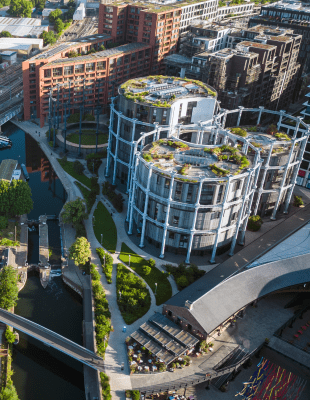First and foremost, buildings and cities must be designed to respond to climate, environment and user needs in a way that requires the least amount of energy and resources to build and operate. Understanding that good design is the foundation of high-performance sustainable buildings, technology opportunities and limitations ultimately shape the last mile of our decarbonization solutions—quite literally the shape and geometry of those solutions.
Starting with the most basic building form, the average one-story commercial building or school in the U.S. can be completely powered by rooftop solar using only 80% of roof area. We can decarbonize these kinds of buildings globally almost overnight. A grocery store, however, consumes more energy for refrigeration, but innovative refrigeration systems can bring energy use down to the same level as that average commercial building. Let’s decarbonize grocery and big box stores—another big win that should be well underway by now, as this is easy technology and an intelligent use of real estate.
At the next level of geometry, the tallest net zero energy buildings embody design excellence but have plateaued at six stories, largely due to efficiency levels of today’s PV panels. In controlled installations, researchers are achieving almost double that efficiency. When those new panels are market-ready, we double the height of the tallest net zero buildings—a game changer for maximizing real estate in a decarbonized world and transforming urban districts into net zero neighborhoods. Net zero building heights inform our definition of the most sustainable cities, as a form-based approach to renewable energy autonomy.
In practice, we decarbonize most buildings by significantly reducing energy consumption through a whole systems approach and electrifying fossil fuel building systems. Deep energy retrofits cost between $20-$60/square foot depending on level of intervention. These integrative projects coincide with architectural upgrades and result in improved interiors and occupant experiences, reducing cap rates and risk and increasing lease income. Solar energy costs have fallen so low that it is less expensive to install renewable energy than to retrofit a building, bringing us back to the calculation of available rooftop real estate. Renewable energy may be less expensive, but finding space for it becomes a barrier, so we must still dramatically reduce consumption or go off-site for renewable energy. Purchasing or developing off-site solar is a little like buying a time share beach condo—you get occasional benefits and pay fees for management in perpetuity, but you’re not really living at the beach. Shorten the distance to your energy sources to improve resilience, reduce line losses, and control source emissions from energy.
Arcadis leverages digital tools to apply this same approach to large scale building portfolios and urban districts. From ten buildings to thousands of buildings, we decarbonize at scale and design for energy transition. Our digital tools for decarbonization analysis are providing insight into many buildings at once and applying available building and energy technologies to meet today’s global climate mandate. As we approach a tipping point for climate action, our biggest opportunity to have impact is at scale—building portfolios, campuses and cities. Understanding the opportunities and limitations of technology is critical to reaching carbon neutrality goals.








